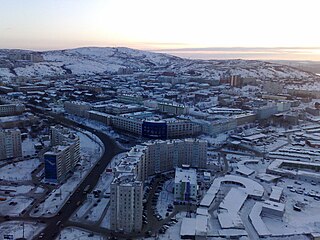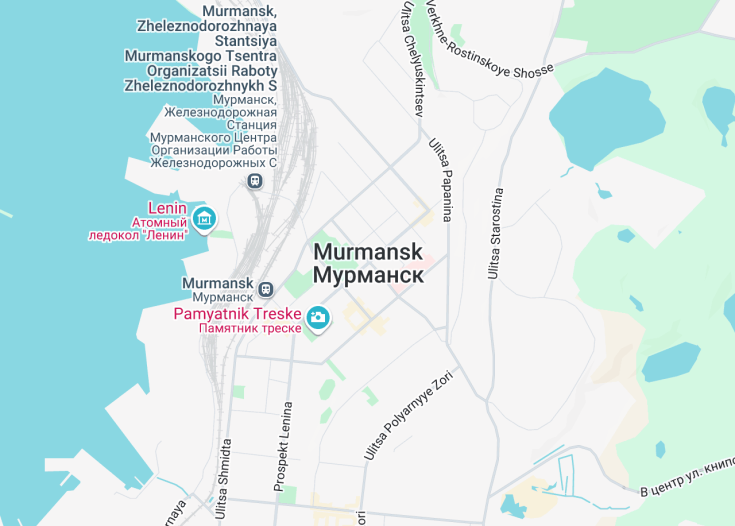Murmansk, a city steeped in naval history and Arctic exploration, is the world’s largest city above the Arctic Circle. Renowned for its unique polar phenomena such as the mesmerizing Northern Lights and the polar night, it offers a fascinating blend of natural wonders and Soviet-era architecture. Visitors can experience extreme conditions alongside warm, local hospitality, making Murmansk a must-visit for those intrigued by life in extreme climates and historical wartime significance.
Pack warm layered clothing, no matter the season, as Murmansk experiences a subarctic climate with long, extremely cold winters and short, mild summers.
Consider visiting during the polar day period from May to July, when the sun doesn’t set, offering 24-hour daylight for a unique experience.
Top things to do & see in Murmansk
Select the following sights and activities to discover best tickets and tours available in Murmansk.
Murmansk: A Gateway to the Arctic
| Country | Russia |
| Time in Murmansk | GMT+3 |
| Language spoken | Russian |
| Population | 294,444 (source: latest census 2020) |
| Currency | Russian Ruble (₽, RUB) |
| Airports | Murmansk Airport (8 mi / 13 km). |
Murmansk, located in the extreme northwest of Russia, is the world’s largest city north of the Arctic Circle. Known for its significant naval base, Murmansk plays a crucial role in Russia’s maritime activities in the Arctic Ocean. Its history begins with its founding in 1916, during World War I, as a strategic port for the Russian Navy and allies.
Today, it serves as an important fishing hub, and its ports are among the few in Russia that are ice-free in winter thanks to the warm North Atlantic Current. Aside from its naval significance, Murmansk is renowned for the stunning natural phenomena of the Northern Lights, which draw tourists from around the globe.The city’s remote location adds to its unique appeal, offering a stark yet beautiful landscape dominated by the Kola Peninsula’s tundra and rugged mountains. Cultural experiences in Murmansk include the Alyosha Monument, a significant WWII memorial, and the Murmansk Regional Drama Theater. The city also hosts several festivals throughout the year, focusing on indigenous culture and the Arctic environment, reflecting its regional importance and diverse communities.
Murmansk also holds historical importance due to its resistance during WWII and is home to the Northern Fleet, one of the most potent naval fleets in Russia. Visitors can explore the Naval Museum to learn about the city’s strategic maritime history. Despite harsh weather conditions, the city has a dynamic energy, with a lively nightlife and a range of dining options that include local Arctic cuisine. Moreover, Murmansk is a starting point for many Arctic expeditions, providing unique opportunities for scientific research and extreme tourism. It has adapted to the cold climate with its infrastructure, including heated sidewalks, and energy-efficient buildings designed to withstand sub-zero temperatures. This adaptation extends to the welcoming nature of its people, making it a warm community despite the cold temperatures.
Where is Murmansk?
Murmansk is located in the northwest part of Russia, above the Arctic Circle on the eastern shore of the Kola Bay.
Distances:
| Route | Distance by car | Time by car |
|---|---|---|
| Moscow to Murmansk | 1,369 miles (2,203 km) | Approx. 24 hours |
| Saint Petersburg to Murmansk | 715 miles (1,151 km) | Approx. 12 hours |
| Arkhangelsk to Murmansk | 448 miles (721 km) | Approx. 10 hours |
What is Murmansk famous for?
Murmansk is particularly famous for its access to the Arctic Ocean and as a viewing point for the spectacular Northern Lights. It’s also known for its large naval base and its resilience during the harsh Arctic winters.
History
1916-1920: Foundation and Early Growth
Murmansk, located in the extreme northwest of Russia, was founded in 1916 during World War I due to its strategic importance as the only ice-free port on the northern coast of Russia. Initially named Romanov-on-Murman, it served as a critical supply point via the Arctic Sea to the Allies. The town quickly grew with the establishment of naval and merchant facilities.
1921-1945: Development and World War II
In the early Soviet era, Murmansk continued to develop as a significant naval base. During World War II, it was a vital point for the Arctic convoys, where war supplies were shipped from the Allies to the USSR. Despite numerous attacks by Nazi Germany, the city never fell, largely due to its strong Soviet defense and harsh climatic conditions. Murmansk’s heroic resistance earned it the title of a Hero City in 1985.
1946-Present: Cold War and Modern Era
Throughout the Cold War, Murmansk served as a key base for the Soviet Northern Fleet. Its importance was highlighted by the presence of nuclear-powered icebreakers and submarines. In the post-Soviet era, the city faced economic challenges but has been working towards developing its resources and tourism sector, focusing on its unique Arctic environment and rich history. Today, Murmansk is a crucial city for maritime and Arctic research.
Visit Murmansk
What to see and do in Murmansk
Murmansk, the largest city above the Arctic Circle, offers visitors a unique blend of historical and natural attractions. Key sights include the Alyosha Monument, commemorating Soviet soldiers of World War II, and the Murmansk Regional Museum of Local Lore, which provides insights into the Arctic environment and the history of the region. Nature enthusiasts can explore the stunning Kola Bay or take a trip to see the Northern Lights during the winter season.
- Alyosha Monument
- Murmansk Regional Museum of Local Lore
- Kola Bay
- Northern Lights observation
Festivals and Events in Murmansk
Murmansk’s calendar is punctuated with several vibrant events, reflecting its rich cultural tapestry. The Polar Night Festival lights up the dark winter days in December, and the Festival of the North, in March, celebrates winter sports and includes the famous reindeer herders’ competition. During these periods, the city is vibrant with activities and traditional festivities.
Best time to visit Murmansk
The ideal time to visit Murmansk is from December to March when the polar night and the Northern Lights create a spectacular natural display. For those interested in milder weather and the midnight sun, late May through July is the best period.
Is Murmansk worth visiting?
Murmansk offers a unique experience due to its Arctic location, rich history, and natural phenomena like the Northern Lights and the polar night. These features make it appealing for adventure and history enthusiasts. However, potential visitors should consider the extreme climatic conditions, which might pose a challenge for those not accustomed to Arctic weather. Despite this, Murmansk provides a distinctive, memorable travel experience, especially for those looking to explore the less visited parts of the world.










